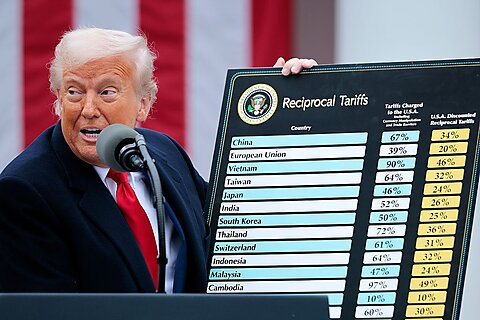Scott Lincicome and Alfredo Carrillo Obregon
Among President Trump’s many new (and unilateral) trade taxes—and by far the most sweeping—are his “reciprocal” tariffs, which today cover a large majority of all goods imported into the United States. As you may recall, Trump expressly sold the measures to the public in terms of “fairness”: US tariffs on goods from foreign countries would simply match the countries’ tariffs and nontariff barriers (NTBs) on American products. “No more, no less,” as Trump said in February when announcing the plan.
Hence, the term “reciprocal.”
Now that this tariff regime is generally in place (despite numerous Cato scholars advising against it), we can assess whether these new import taxes live up to their name—at least when it comes to other countries’ tariffs on US exports. (Assessing the NTB claim is impossible because the administration never comprehensively quantified countries’ NTBs; regardless, the administration’s original—and not credible—reciprocal tariff formula, supposedly incorporating NTBs, has been discarded.)
You may be (but since you’re reading this, probably aren’t) surprised to learn that there’s nothing “reciprocal” about these “reciprocal tariffs.” In fact, the Trump administration’s new tariff regime,
Only once matches new US tariffs to other countries’ tariffs (and rarely even gets close to such a match);
In the vast majority of cases—and for all major US import sources and free trade agreement (FTA) partners—it sets US tariffs at rates much higher than those foreign governments apply to American goods; and
Whether intentionally or not, it actually tends to impose higher tariffs on countries with lower tariffs on US exports.
Make it make sense.
Let’s start with the last point first. Figure 1 plots the country-specific “reciprocal” tariffs imposed by President Trump last week and the most recent World Trade Organization data on those same countries’ tariffs on US goods. (Roll over each dot to see a country’s tariff in both instances.) A truly “reciprocal” tariff regime would show these two numbers to match (or, at least, be roughly in the same ballpark). Thus, a US reciprocal rate of, say, 10 percent would mirror a government’s 10 percent average tariff rate on US exports, and we’d see a trendline moving up and to the right in the chart. Instead, we see no such relationship and, in fact, the opposite trend: reciprocal rates, especially those for countries singled out by the US for a special (not “baseline”) tariff, tend to be higher for countries that charge lower tariffs on US exports.
A widely reported example is that of Switzerland, which, despite levying a trade-weighted average applied most-favored nation (MFN) tariff of 0.2 percent on US exports, now has its exports subject to a whopping 39 percent US “reciprocal” tariff. Other countries with low tariffs on US exports, such as the EU (1.7 percent), New Zealand (1.5), Indonesia (4), Vietnam (2.9), and even India (6.2), got hit with comparatively high US duties (15 percent, 15 percent, 19 percent, 20 percent, and 25 percent, respectively). The 10 percent baseline tariff has a similar asymmetry for developed countries, even ones with zero (e.g., Singapore) or near-zero tariffs (the UK at 0.9 percent) on US goods. (Many poor nations have high tariffs because it’s the only way they can raise revenue.)
Overall, Figure 2 shows that about 80 percent of the US “reciprocal” tariff rates—as applied to 144 foreign countries for which the WTO reports tariff data—are higher than those countries’ average tariffs on US exports. The situation is even more unbalanced for the biggest US import suppliers: for all of the top 25 countries from which the United States imported goods in 2024 (excluding Canada and Mexico, as they do not have “reciprocal” rates), the “reciprocal” tariff rates are higher than these countries’ tariffs on US exports—and the former exceeds the latter by almost 12.5 percentage points on average (Figure 3).
Importantly, these figures do not address the fact that multiple countries have signed FTAs with the United States, eliminating most tariff and nontariff barriers and thus applying even lower tariffs to to US exports than the already-low “MFN” rates listed for these countries above. As Table 1 shows, these agreements—which, unlike Trump’s tariff “deals,” are legally binding and have been approved by Congress—offered partner countries little refuge from “reciprocal” tariffs, which are on average 11.5 percentage points higher than the preferential rate these governments give US products. Unfortunately, President Trump’s unilateral actions have obliterated the real reciprocity these governments thought they were getting when signing these agreements.
TABLE 1
In sum, the US “reciprocal” tariff regime is nothing of the sort, with new US tariffs in most cases (and in all important ones) far exceeding the average tariffs that foreign governments apply to American goods. This revelation is more than just a rhetorical gotcha: tariff advocates, including Trump himself, have long justified new US tariffs on the grounds that they were needed to balance foreign tariffs, which are supposedly quite high, on American goods. The data above reveal this justification to be empty—especially since the “reciprocal” tariffs in almost all cases apply (“stack”) on top of existing US tariffs, which in many important instances (e.g., pickup trucks and shoes) are themselves substantial.
Overall, the data further demonstrate that US tariffs today are about protectionism, with “fairness” and other buzzwords simply a cover for achieving it.

